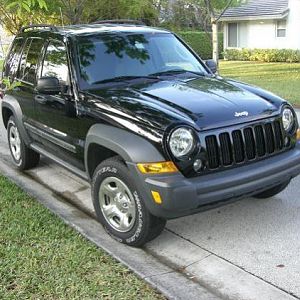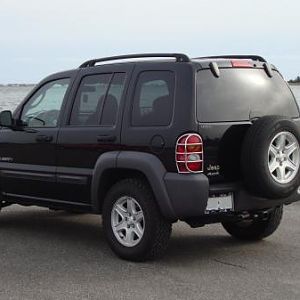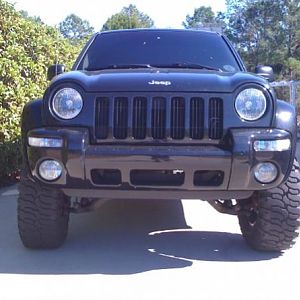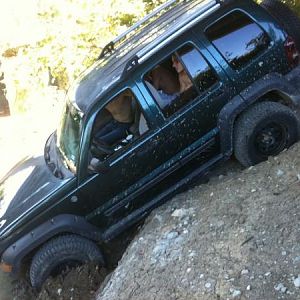I want to give a detailed explanation of why I think any KJ with the HD shroud, and no clutch fan, is a ticking time bomb on these engines and transmissions.
I hope this helps anyone better understand our cooling system designs.
First, let's address what I am talking about. The KJ's were available with two cooling options, Standard cooling and HD.
Standard is just an electric fan with a shroud. The shroud is small and only protrudes about 4-6 inches off the radiator (I think). The fan is "sealed" in the shroud, meaning the gaps are minimal and the fan is efficient (let's not argue that) at drawing air through the radiator. I don't know the turn on temps.
HD cooling uses a much larger fan shroud, protruding all the way to the snouts of the A/C compressor and the alternator. This cooling is designed around the clutch fan and uses an electric fan as secondary cooling. My understanding is all 2004's came with the HD shroud, not sure about other years.
Let's talk a bit more about the HD cooling as the standard cooling is extremely simple and straightforward, and there seems to be some differing opinions about this HD cooling design. This is my opinion.
If you have the HD shroud and no clutch fan, take a look in the shroud. You will see an electric fan in there. What you should also notice is the rather large gap around the fan on the upper and right side. That gap significantly reduces the efficiency of that fan in that shroud. It will struggle to pull good air through the radiator with that gap alone. Especially when you consider pulling air through a radiator, A/C condenser and even a trans cooler. The standard cooling fan is much better "sealed" in it's shroud because it is the primary, and only, cooling fan.
Now, imagine the clutch fan is installed, it "seals" in the shroud with less than an inch gap around it. Now that electric fan can actually provide some help to the clutch fan because it is increasing airflow in an already "sealed" shroud. Now we are actually pulling good air through the radiator.
Without the clutch fan, that electric fan in that shroud is not efficient (it's just ok at best). Add to that it waits until the engine has risen to 219 degrees before it even turns the low speed on, it's no wonder they like to run hot a lot of the time like that. This HD shroud should always have the clutch fan installed, it's the primary cooling fan, the electric fan is secondary cooling to assist the clutch fan in high load/heat situations.
The shrouds are designed around the fan that seals the gaps best in it. The electric fan does not properly seal by itself in the HD shroud, therefore it is not the primary fan, which is why it doesn't turn on the low speed until 219. Especially when considering how well the clutch fan seals in the HD shroud. The clutch fan doesn't really need the electric in front of it, but in towing it would be helpful to have that electric fan provide more airflow in high load/heat situations, not just for the engine, but the trans cooler as well. Think low speed hill climb towing, pulling away from a light uphill.
And let's not forget the factory water temp gauge will only move off the half way mark when it it climbing over 228 (I think that's the number). Without the clutch fan, she can run up to 225 all day long and that gauge will read half the whole time, you'll never know what's going on unless you notice the fan coming on and know that means she hit 219.
I, honestly, for the life of me, cannot understand why these vehicles were sent out of the factory with the HD shroud and no clutch fan.
This is a recipe for hot running engines and transmissions. Remember, no active cooling across the trans cooler either without the clutch fan. And it is probably not very good airflow at all across the trans cooler with the electric fan on in that shroud.
So, anytime your KJ with the HD shroud and no clutch fan is sitting idling, climbing at low speeds, or any low-to-no airflow situation, she is wanting to overheat and your gauge is not letting you know until she is already hot.
Imagine it sitting in 90 degree heat without the A/C on in traffic, every time you hear the electric fan turn on she hit 219+, and if the gauge has started moving up she is probably already over 230.
All kinds of electrical bugs can arise from constant high under hood temperatures, especially after a decade or more of it.
I see this as a ticking time bomb on an engine that doesn't like being overheated or run hot and a transmission that also doesn't like being overheated or even run hot.
Why, knowingly, allow our KJ's to run like that? I really like this Liberty, am looking forward to driving it until it falls of a mountain.
I live at 6500' in the Rockies, I have replaced 2 motors and a trans in 18 months as a direct result of cooling issues. I finally realized (that dang electric fan in there tricked my brain, and everyone else's, for a while) the importance of the clutch fan in the HD shroud, even going so far as to remove the electric fan in the shroud (better airflow without it). The computer doesn't care, no code, and the motor has never gone over 204 since putting the clutch fan on. It'll never hit 219 with my 3 row aluminum radiator and the clutch fan.
As long as my motor spins 1500 rpm it's enough airflow to keep it cool, even running up steep mountain inclines in 70 degree heat, 8 miles of winding dirt road trail, 10-25mph from 7000' to 9500', never hit 205, yeah, clutch fan!










